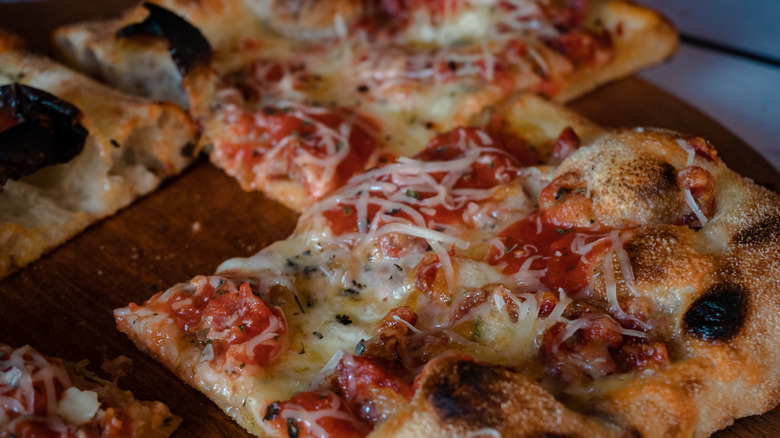What Sets Grandma Pizza Apart From The Standard New York Slice
New York garners much acclaim for its classic New York slice: thin, crispy pizza, generally cut into large triangular slices meant to be folded in half for consumption. However, while many locals might claim that traditional New York City pizza is the best, another "New York slice" often flies under the radar. Grandma pizza, characterized by its dense square slices, originated on Long Island, and is often found in and around the greater New York City area for those who take the time to search.
There is a significant difference between Grandma pizza and the New York slice. Visually, of course, the primary distinction is clear: Grandma pizza is rectangular, whereas a New York slice is cut from a circular pie. When sliced, several square pieces of Grandma Pizza could fit into one blanket-like, triangular New York slice. However, the variations extend beyond shape; they differ texturally as well. While both boast crispy bottoms, a Grandma slice is denser, whereas the slender New York slice remains manageable even when folded.
Origins of Grandma pizza
Grandma pizza is thought to have been created, or at least popularized, by Italian immigrants living on Long Island in the 1970s, and gained further prominence through the Nassau County pizza shop, Umberto's. Its name originates from the idea that it was traditionally made at home by older Italian women, using an olive oil-slicked rectangular sheet pan in a home oven, instead of on an exposed flat surface in a professional pizza oven. It is a slice made with efficiency in mind, featuring a short proofing time that lends it a denser texture compared to a New York slice. And though Grandma pizza is often confused with Sicilian pizza, as both are served in square slices, Grandma pizza doesn't have the fluffy, almost focaccia-like texture of a Sicilian slice — its crust is thinner and far more crispy.
This style emerged much later than the New York slice, as the first pizza shop in New York City was opened in Little Italy in 1905 by the Neapolitan grocer, Gennaro Lombardi. However, the Grandma slice remains a home-cooked favorite for many in the New York area.
It's all in the layers
One of the most noticeable idiosyncrasies of Grandma pizza is that it is typically covered with cheese first, then sauce, flying in the face of traditional pizza conventions. (Although you can get a white Grandma slice without tomato sauce, usually topped with dollops of ricotta.) In contrast, most other types of pizza in the U.S., including New York slices, adhere to a sauce-first protocol, allowing the sauce to seep into the bread, and giving the mozzarella on top a broiler-like finish. Detroit-style pizza is another exception, adopting Grandma's cheese-first approach.
The olive oil used to grease the pan for Grandma pizza is key to its delicious crispiness. On the other hand, a New York slice incorporates olive oil in the dough, but is baked on a bare surface. From this base, you can add any toppings you like, although both styles are traditionally served with just tomato sauce, mozzarella, and no additional toppings. After all, why mess with perfection?



